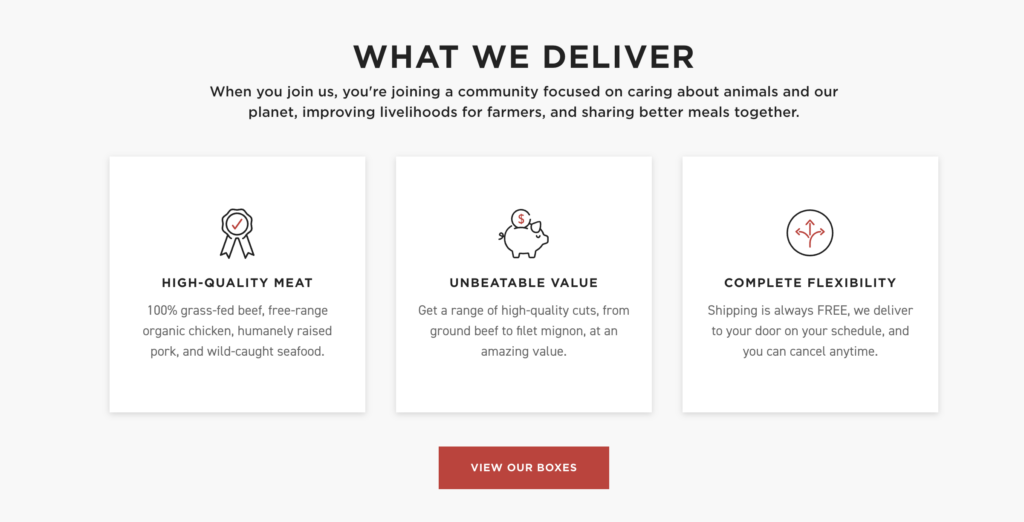Brand positioning is more than how you’re different from your competition. It’s the “space” you occupy in your ideal client’s mind.
So for example, if I spout off the name “McDonald’s”, certain ideas about this brand will come up: “cheap, fast-food, hamburgers, why am I all of a sudden craving a McDouble?”
Apply this exercise to any well-known brand: Apple, Amazon, Gucci, Nike, Coke, the list goes on. When you do, immediately certain words, phrases, ideas, and emotions fill your brain. These are the same deliberate words, phrases, ideas, and emotions that a bunch of marketing gurus spent hours in a boardroom brainstorming over, just to make sure they’d fill your brain.
You know you have clear brand positioning when how YOU want to be known and seen in the market directly syncs up with how your audience actually knows and sees you.
So if corporations leverage brand positioning, does that make it at all relevant for a small business owner like you? The answer? A resounding yes.
Why is brand positioning important for small businesses?
It’s tempting to think some strategies from the world’s industry giants (Apple, Amazon, Nike, etc.) don’t apply to your small business. Clear brand positioning is definitely one that doesn’t apply. It must be leveraged.
Whether you’re making $100K/year or $1M/year, attention is currency, and we’re all fighting for it.
Just think of all the hundreds of thousands of businesses that do exactly what you do. If you aren’t actively standing out, you’re only blending in.
By nailing your brand positioning, you’re essentially saying“Hey, this is who we are, what we do, who we serve, and what we stand for!”
It helps you get attention from not just anyone, but people who hit the sweet spot when it comes to your ideal client.
So before I fully answer the question “What is brand positioning?”, let me first explain what brand positioning does for you. It…
Makes marketing easier — On days when you tell yourself, “I have literally no idea what to post today”, brand positioning takes you from feeling lost to brimming with focused content ideas that move the needle in your business.
Establishes audience + customer loyalty — Ever invested in a brand expecting one thing, but left with a disappointing experience? Your audience hates that too. Brand positioning keeps you in your zone of genius and creates clear expectations, which leads to happier clients and customers.
Easily builds brand collaborators — As you grow in visibility, the more important it is to align yourself with businesses parallel to you, so you can expose yourself to different audiences. Clear brand positioning makes it easy to decide who is and isn’t worth syncing up with.
Creates clarity for business growth moving forward — Whether it’s diversifying offers or taking away services, clarity in your positioning helps you determine ideas that feel good with how you want to grow moving forward.
Now that you know what brand positioning does FOR you, here’s how you can start to craft yours:
How to craft your brand positioning: The Brand Positioning Box
Yes, brand positioning is something you can craft initially. Just remember: as you find your footing in the market (what you do, who you serve etc.), your brand positioning will slightly shift over time.
That’s okay and completely normal. For now, let’s go over the Brand Positioning Box so you can understand what makes up brand positioning as a whole.
What is brand positioning in action? Well, I’ve been a happy customer of meat subscription, Butcher Box so I’ll be using it as an example so you can see how each category works.
Sorry, I couldn’t help the double usage of the word “box”, here. It was set up perfectly.
Your Solution
First off on the top left corner of the Brand Positioning Box is “Solution”. It’s the easiest to nail down because it represents your offers: your products, your services, and the things you sell that make your business money.
I recommend that even if you choose to take projects outside your normal scope, your marketing and website should reflect the offers you want to sell the most.
REAL-LIFE EXAMPLE — BUTCHER BOX:
Butcher Box’s solution is a meat subscription. They aren’t an in-person Butcher Shop. They don’t sell meat at a farmer’s market.
They sell frozen meat you choose online, which comes in a box, delivered to your door.
Your Sphere of Influence
Your sphere of influence means who you serve in your business. When most people think of their ideal client, they immediately go to their demographics like, “30-year-old female married with two kids”. Sure, demographics are part of it, but you also want to consider their:
- Buyer persona types — Read the blog about how this influences psychological buying patterns
- Geographic location — If the person you serve is based in a certain location
- Personal values — The things, topics, people, and ideas they strive to live by
- Stylistic preferences — A certain approach or style in your work that they can’t find anywhere else
REAL-LIFE EXAMPLE — BUTCHER BOX:
Butcher Box serves the person who cares about putting ethically-sourced, quality meat into their body. That means finding a way to eat meat that focuses on animal welfare, supporting farmers, and treating the planet with respect.
To become that person’s top solution, Butcher Box sources meat that’s humanely raised, vegetarian/grass-fed, and with no antibiotics or added hormones.
Your Story
Your story plays a huge role in brand positioning because according to Harvard scientists (and plain old human experience), our brains are literally wired to engage more when we hear them. What’s even better? No one else can copy, take, or inmate your story, because it’s yours.
If you aren’t sure what your story is, don’t think it has to be a full-on novel. Start by asking yourself these simple questions to get you started:
- Why did you start your business? What parts of your coming-up story would resonate with your audience?
- What opinions or points of view do you have about your industry since starting your business that your audience would also agree with?
- Do you have a certain amount of years of experience in something or have you reached certain milestones that add to your credibility?
- Do you share any personal interests or personality traits your audience can relate to, especially if you are a personal brand?
REAL-LIFE EXAMPLE — BUTCHER BOX:
Butcher Box’s founder, Mike Salguero, connected with a local cattle farmer in 2015 and for the first time, ate meat that was 100% grass-fed beef. He learned from that experience that this kind of meat tastes way better, but importantly, that more people deserve easier access to high-quality, humanely raised meat.
Your Style
The final corner of the Brand Positioning Box is style. Style doesn’t necessarily have to mean “creative style”, although that’s certainly a huge part of it if you’re a creative business owner. Style also means highlighting certain features of your offer you know your ideal client values the most. Playing around with these different angles will help you understand what this could look like for you:
- Is your brand high-end or accessible?
- Do you emphasize quick results or slow and steady progress?
- Is engaging with your product/service high-touch or hands-off?
- Does your product/service focus more on data or emotional appeal?
- Is your product/service a one-time solution, or an ongoing relationship?
- Are you more concerned with quality or quantity?
REAL-LIFE EXAMPLE — BUTCHER BOX:
Butcher Box highlights three features of their offer because they know it’s what their audience cares about the most: high-quality meat, unbeatable value, and complete flexibility. They’ve even got it listed right on their homepage:

Having a hard time narrowing down each category of your Brand Positioning Box because you want to be everything to everyone? I hate to be the bearer of bad news, but as the saying goes, a jack of all trades is a master of none.
And what is brand positioning if it’s not helping you stand out as an authority in your space?
So I want to share one more term with you that might make it easier for you to cut what isn’t working in your business, from a brand positioning standpoint, and lean into what is.
What is constraint in brand positioning and why is it important?
Constraint in your brand positioning is like putting a fence around your brand, defining what it is, but more importantly, defining what it isn’t.
And that means having the confidence to say “We don’t do this, we don’t serve these audiences, and we don’t believe in these things”.
Going back to the Butcher Box example, it’s clear they aren’t for vegans or vegetarians. I mean, that should be clear from the name itself.
They also don’t serve people who want meat that’s dirt cheap, either.
Butcher Box carved out this space for themselves in the market on purpose. Why? Because it makes it SUPER easy for the *right* people to say “Oh yeah, this is exactly what I’m looking for.”
Put this in the perspective of your own decisions when choosing to follow or invest in a brand. Do some of them make you feel empowered, while others give you an uneasy pit in your stomach?
Then think about WHY that’s the case. Is it their brand voice? Does what they stand for as a brand go against everything you believe in? Do they give off a vibe that doesn’t sit right with you? Having this self-awareness will help you understand even more what you want YOUR brand positioning to be in the future.
So yes, at first glance constraint sounds limiting. But when you get it right, it’s actually liberating. You’re free to go all in on the right offers, the right people, the right story, and the right style to make some serious traction in your business.
In summary, what is brand positioning?
Brand positioning is the art of strategically establishing a memorable place in the mind of your ideal clients and customers. Which then makes it even easier for you to stand out. Want more help with your own brand positioning? Start with a brand message framework.
Or, you can download The Art of Pivoting Your Business and Message Guide. Inside, you’ll find the common culprits of brand positioning angles that sell yourself short, where they most commonly hide, and how to pivot into a message that articulates your value.
free download!
5 Tips to Instantly Improve Your Website Copy in An Afternoon
Action-packed methods so your website can spark connections swiftly. Around the same time it takes to finish a leisurely afternoon stroll with a good friend — we should really do those more often.
